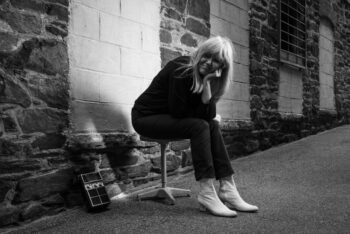
Welcome back to Sound & Vision, the Rumpus profile series that spotlights the creative talents of those working behind the scenes in the music industry. In this installment, I’m excited to talk with Miriam Linna. Originally from Ontario, Canada, Linna spent her formative years in Ashtabula, a very small town about fifty miles outside of Cleveland. After running bands’ fan clubs as a student at Kent State, Linna moved to New York where she was recruited to play drums for the first lineup of the Cramps. Going on to join the Zantees and the A-Bones, Linna also founded several zines, including Kicks, along with her bandmate and future husband Billy Miller. Kicks grew into paperback book company, publishing the likes of Andre Williams, Sun Ra, Kim Fowley, and others. Linna and Miller also founded the independent record label Norton Records, which specializes in showcasing previously unreleased gems as well as fantastic reissues of rockabilly, garage rock, and early R&B, including Link Wray, the Dictators, and Flat Duo Jets. Explaining what drives her desire to champion great undiscovered talent, Linna says, “To me, being a fan is the greatest thing I could ever accomplish in life.”
***
The Rumpus: How did you first get into drumming? Were you self-taught?
Miriam Linna: [Laughs] Yes! I was basically handed a pair of sticks and told, “Go at it!”
Rumpus: Tell me more—had you had much experience before joining the Cramps?
Linna: Well, I moved to New York on July 4th, 1976. It was the bicentennial, and it was a wild weekend. The tall ships were in and there were fireworks going off, and I felt like I was getting quite a welcome. [Laughs] But even before I came to New York I was already friendly with Lux [Interior] and [Poison] Ivy, who were the prime movers in the Cramps. I had actually run into them at a restaurant when my sister and I were visiting New York about two or three months earlier, and we figured out we were all from Ohio. They ended up visiting me out there. I knew they were looking for a drummer, and they asked if I played. I didn’t at the time, but I taught myself and caught on quickly. Actually I did have one lesson—from Tommy Ramone—but that was about it. That was all I needed! [Laughs]
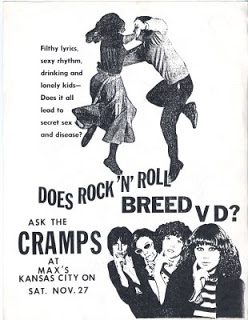 Rumpus: I understand there were several punk/underground bands coming out of Ohio around this time. The Dead Boys were from there too, right?
Rumpus: I understand there were several punk/underground bands coming out of Ohio around this time. The Dead Boys were from there too, right?
Linna: Yes, the local scene was very small but also very loyal. I knew the Dead Boys before they left Ohio, and I was pals with Stiv Bators, their fearless leader. When they came to New York, they moved into my apartment while they were looking for a place of their own. At the time Cleveland was also an important music town for non-local bands, especially as a testing ground for British groups. The idea was that if you could cut it in Cleveland, you could make it anywhere in the US. There was a station called WMMS, which had Kid Leo as one of its DJs. He’s at Sirius now, but back in the day he was a young guy who really held sway over all of Northeast Ohio. The Cleveland fans often knew about bands first—before they made it to New York or wherever.
Rumpus: Was the music scene you encountered in New York as close knit as Ohio’s?
Linna: Yes, it was really a great time. I liked that people were aggressively showing off their non-prowess as musicians and making a bit of a statement with the noise they were able to put together based on records that we all loved. Like with the Ramones, they were big fans of the girl group sound, and with me and a lot of the other musicians from Ohio and Detroit, we were into what would later be called a kind of “garage” sound. We were all heavy-duty Stooges fans. We’d seen them as teenagers, and it really affected us. You know that first year I played with the Cramps there was never really a drive to be big or anything like that. It was simply playing for and with your friends in a tight-knit group of people who met up together and made a racket. None of us expected it to end up being what it became. I prefer the way it was in those fledgling years.
Rumpus: After you left the Cramps, you continued to play drums in several other groups.
Linna: Right after the Cramps, my future husband Billy and I were in a group called the Zantees, and we made a few albums with them, and then we went on to another group called the A-Bones with different members. We’ve been with the A-Bones since time immemorial. [Laughs.]
Listen to the A-Bones song “Geraldine”:
Rumpus: And you and Billy also have a long history of publishing together—when did that start?
Linna: We started Kicks in 1978. It came out of a whole sort of fanzine mentality, us wanting to be in touch with others and to pass on information we’d gained about totally unknown groups and music that we really dug. We were both big fans of magazines like New York Rocker, which Alan Betrock ran, and several others. We wanted to be connected with other likeminded people, and at the time, you couldn’t make long distance phone calls—some people didn’t even have their own phones—so we were basically letter writing.
I still have scads of old letters from friends in Detroit and in small town Ohio. They’d say things like, “Hey, I’m gonna go see Iggy. He’s playing at the public auditorium!” And then I’d write back like a week later, “Oh, we want to go too!” And you’d describe the shows to your friends who couldn’t make it. And eventually that grew into this fanzine thing where maybe you’re writing back and forth with ten or fifteen people around the country, and then you’re mimeographing your correspondence. Kicks kind of grew out of that.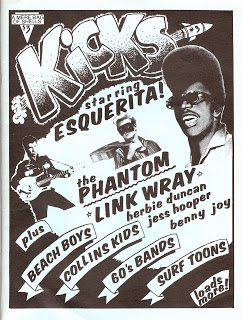 I’d already been doing a fanzine for a group called the Flamin’ Groovies. Billy was a fan of Paul Revere and the Raiders, and he wanted to do a Raider fanzine, so we got decided we could write about both, and have friends of ours write about other bands they loved. We’d also review records—not current records—but crazy ass records we’d find in thrift stores and so on that were a total delight and surprise. You know it was the typical record collector mania that thankfully survived and thrives today.
I’d already been doing a fanzine for a group called the Flamin’ Groovies. Billy was a fan of Paul Revere and the Raiders, and he wanted to do a Raider fanzine, so we got decided we could write about both, and have friends of ours write about other bands they loved. We’d also review records—not current records—but crazy ass records we’d find in thrift stores and so on that were a total delight and surprise. You know it was the typical record collector mania that thankfully survived and thrives today.
Rumpus: Was it a lot harder to find hidden gems back then than it is today?
Linna: Well, this was in the dark ages before eBay! At least for myself, starting out in the boondocks in Ohio, it was a solitary search for thrills. All of us who made it to New York were square pegs in the little corners of the world where we came from. It was a thrill finding friends who loved the same stuff you did.
Rumpus: How did your work with Kicks lead to starting Norton Records?
Linna: The label started only because we’d found this crazy, wonderful, super-talented hillbilly cat named Hasil Adkins. We’d done a cover story on him in Kicks and everyone wanted to hear what he sounded like. His story was just incredible. He would eat raw meat and sing songs about cutting girls’ heads off and hanging them on the wall, and he lived out in the wilds of West Virginia, and so on. And when we found Hasil he had all of these tapes and recordings and we thought maybe we could get something together so the world could hear this.
Listen to the Hasil Adkins song “No More Hot Dogs”:
When we put that first record out at the request of Kicks readers we had no intention of starting a record label. But then suddenly Esquerita who was a friend of Little Richard—and an incredible black screamer and piano pounder—came into our life. He ended up in New York, so we ended up doing a second record, then a third, and after a while it evolved. It was always about unknown music by super-talented individuals who we thought should be the top dogs.
Rumpus: How did you manage distribution, particularly before e-commerce?
Linna: It was tough! I mean you could have a couple of small space ads. Midnight Records was one of the really great stores, and a little space ad there would cost us maybe $15. And there were also a few magazines and fanzines that covered this stuff, and we’d put out a flier with Kicks too. It was a small effort at first, and virtually all mail order. And then you know we went under with Hurricane Sandy, right?
Rumpus: Yes, I’d heard that! But you’re still going in your twenty-ninth year, when a lot of other labels have permanently gone under.
Linna: Well, here’s the crazy thing, the good thing to come out of this terrible thing: When Sandy happened we had to pull everything out of the water. I had saved every single order, every single cancelled check, every single piece of ephemera, everything that ever happened with our magazine and record label, and everything before that! We were packrats, but we also had everything organized in boxes. The boxes were unsalvageable, but for that moment we were able to open them up and cry and realized, wow, there really was this energized effort to be in touch with people who were equally excited and supportive. When Sandy hit we lost a quarter million records under water, but it also reminded us of how we grew from that first record, how we made a successful effort that was totally fueled by fandom.
Rumpus: Kicks Books is the most recent extension of that effort. Can you tell me how the Kicks zine grew into a publishing company?
Linna: We’d been doing the Kicks zine since ’78 and Norton formally since ’86. I started Kicks Books in 2009 as a promise to Andre Williams, who was one of our recording artists, a great R&B, shake-your-tail-feather guy from Detroit. He was in his early 70s at the time, and he’d been put into rehab, having had serious drug issues throughout his adult life. He called me one day—this is going back about seven years now—and said, “I’m in rehab now and I’m bustin’ out.” I was friends with him, so I said, “Andre, you can’t do that. If you leave you’re not going to live.”
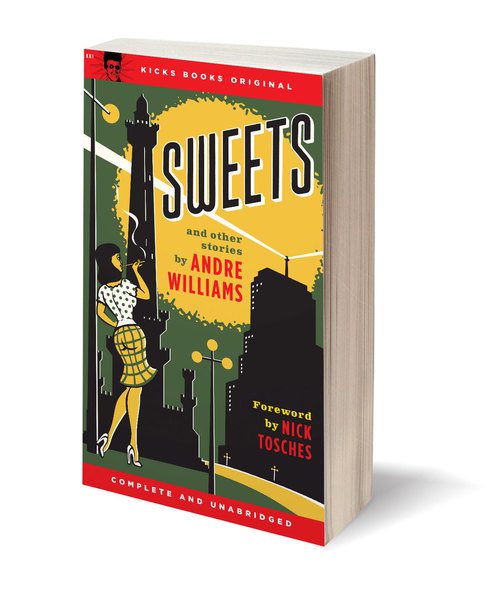 And I don’t know where I got this, but I said, “Andre, you’re a great songwriter. Why don’t you write your own story?” He had done so much in the formative years of rock ’n’ roll that influenced us and everyone else, but he didn’t think he had anything to say about his life. So we talked about writing fiction, and he said okay but only if I promised to stay with him on it because if he stayed in rehab that would be his project, and they’d stay on his back to make him do it. Not thinking that anything was going to happen, I told him that if he finished the project I would publish it as a book. That’s exactly what ended up happening. I think the writing gave him a kind of fantasy world. It was so exciting. He wrote himself clean! And it became the first Kicks book, and from that other book projects starting coming in right away, from heroes of mine like Nick Tosches, Harlan Ellison, and Kim Fowley. My idea was that these would be “hip pocket books” that would take you on a wild analog rush when words on a printed page cause your heart to race, your hair to stand on end, and your body to sweat. I love that whole kind of crazy, mysterious connection, whether putting a needle down on a record or reading pages in a book.
And I don’t know where I got this, but I said, “Andre, you’re a great songwriter. Why don’t you write your own story?” He had done so much in the formative years of rock ’n’ roll that influenced us and everyone else, but he didn’t think he had anything to say about his life. So we talked about writing fiction, and he said okay but only if I promised to stay with him on it because if he stayed in rehab that would be his project, and they’d stay on his back to make him do it. Not thinking that anything was going to happen, I told him that if he finished the project I would publish it as a book. That’s exactly what ended up happening. I think the writing gave him a kind of fantasy world. It was so exciting. He wrote himself clean! And it became the first Kicks book, and from that other book projects starting coming in right away, from heroes of mine like Nick Tosches, Harlan Ellison, and Kim Fowley. My idea was that these would be “hip pocket books” that would take you on a wild analog rush when words on a printed page cause your heart to race, your hair to stand on end, and your body to sweat. I love that whole kind of crazy, mysterious connection, whether putting a needle down on a record or reading pages in a book.
Rumpus: This might be a good segue to talking about your most recent Kicks Book, I Fought the Law: The Life and Strange Death of Bobby Fuller, which you co-wrote with Randell Fuller. How did that one come about?
Linna: I Fought the Law grew out of an article I wrote for Kicks #6 in 1989. Billy and I did these crazy road trips. We did one in Texas that went from Austin to Dallas and then out to West Texas on a mad record hunt at an old record store that had just gone out of business. When I was out there, I called a guy I knew in El Paso because I was a Bobby Fuller fan, and I just thought how far away could we be from there? Well, actually it turned out we were hours and hours away, but he said we needed to just start driving because Randy Fuller [Bobby’s brother] was in town. We drove through the desert, and met Randy, and he took us to his parents’ house—this is the place where Bobby and Randy had built a recording studio and made albums—and the whole house was intact. Nothing had happened in that house since July 18th, 1966 [when Bobby died]. It was staggering.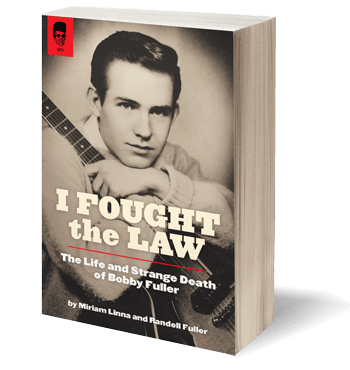 Every appliance was from the mid-’60s, the carpeting, the wallpaper. Mrs. Fuller took us into Bobby’s room, and it was exactly as he had left it. His clothes were hanging in the closet, his shoes were on the floor, and there was a jacket on the bed.
Every appliance was from the mid-’60s, the carpeting, the wallpaper. Mrs. Fuller took us into Bobby’s room, and it was exactly as he had left it. His clothes were hanging in the closet, his shoes were on the floor, and there was a jacket on the bed.
Rumpus: Wow. That must have been wild!
Linna: It was. Randy then took us in his ’63 Corvette through the hills of El Paso. That was the car that he and Bobby had, and all of the loneliness, the weird/good/bad/ugly vibe of El Paso was so apparent. I told Randy that I really wanted to do a story on Bobby and him and the whole El Paso scene. It grew into a very big story.
Rumpus: A lot of people know Bobby as the guy associated with the Top 10 song “I Fought the Law”—but what don’t they know about him?
Linna: Bobby was a “DIY” pioneer. He was such a great musician and such an intelligent, inventive thinker. He recorded his own records in a studio that he built, and he worked at music stores, so he knew about every new invention. He befriended the taste-making disc jockey, knew how to promote his music, and he even opened his own teen club, where his was the house band. He brought the wet reverb sound of surf music to a desert town and translated it for drag racing, dune buggy kids who had never seen the ocean. He did this all while in his late teens and early twenties, before he died at age twenty-three. Randy came to us about three years ago, wanting to tell the real story of his and Bobby’s life together, not what had been reported here and there without his input. We just did the book launch in Los Angeles, and it was packed! Randy and DeWayne Quirico, who had played drums with the Fuller brothers in El Paso, played Bobby Fuller songs along with two other musicians. There were so many people there that night the fire department came out!
Listen to the original 1964 Bobby Fuller demo for “I Fought the Law”:
Rumpus: And as you’ve helped other musicians and writers to share their music and stories, you’ve also recently released your first solo album?
Linna: Yes, that’s right! Supporting other people and pushing for them, that really has been my role more than being the front person. And I kind of feel like the real me is more behind the scenes, but a little over a year ago, Sam Elwitt called up and said he had this idea to try to accomplish a kind of West Coast studio/girl group sound, and he wanted me to sing on a couple of tracks. And of course it seemed ridiculous to me at first because I’m not a singer per se, but we worked together, and I really enjoyed the experience, and so did he, and it grew into an album! And then people asked us if we could play live, so we’ve done a handful of shows. I really didn’t know what was going to happen. I really didn’t know about singing in front of a microphone, that full on. I’d never been that bold. But I thought, Hey, if I fail, I fail. I found I really enjoy being out there on that side as well, warts and all. Singing is a total blast!
***
BONUS MATERIAL
Watch Miriam perform two songs from Nobody’s Baby live:
Rocket from the Tombs is one of the proto punk bands to emerge from the ’70s Cleveland scene, its members going to form Peter Ubu and the Dead Boys. When the band reformed in 2003 with its original lineup, singer David Thomas dedicated the song “Amphetamine” to Miriam:
***
Feature photo of Miriam Linna © Jacob Blickenstaff. All other images courtesy of Miriam Linna.
***
This interview has been edited and condensed. If you’d like to recommend someone for “Sound & Vision,” drop Allyson a line here.




